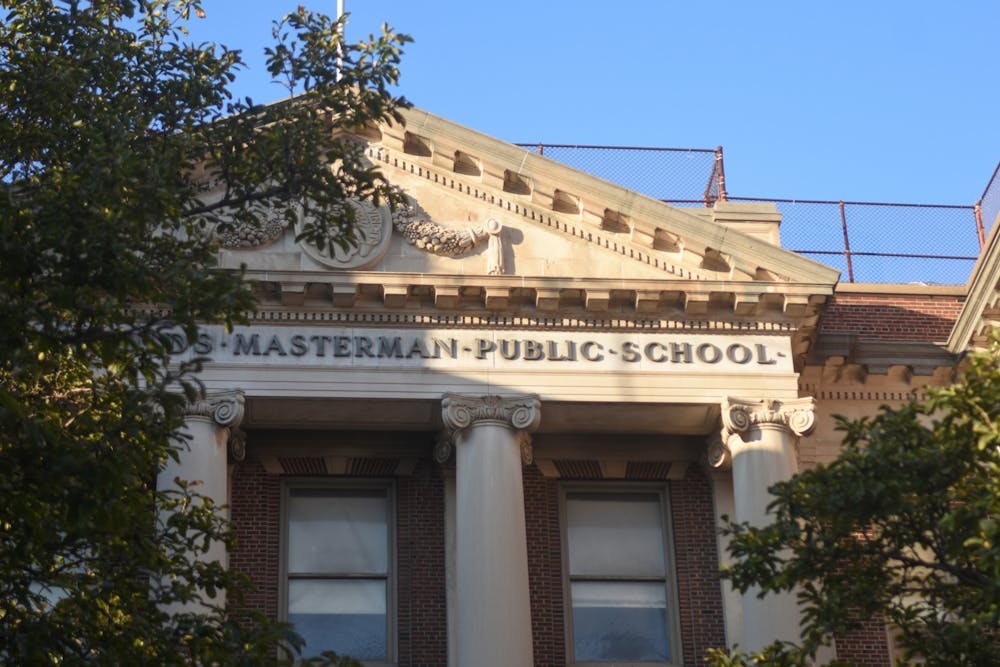
The Julia R. Masterman Laboratory and Demonstration School in Center City is one of Penn's feeder schools.
Credit: Derek WongIn her blog post welcoming the admitted class of 2027, Dean of Admissions Whitney Soule wrote “And, speaking of Philadelphia, we cannot wait to welcome our Philadelphia students — one of the largest Philly cohorts we’ve admitted to Penn.” The number of students Penn accepts from the greater Philadelphia area grows larger each year, but is Penn’s favoring of Philly students actually benefiting the city? In execution, what is this special attention truly accomplishing?
At first glance, this continuous upward trend in Penn’s Philly admits seems to be the perfect way to alleviate tension created by a private university eating up so much land in the city. In return for its ever-growing presence in Philadelphia, Penn is taking additional care with applicants residing in the school’s vicinity. This has long been regarded as a way for Penn to “give back” to the city and its residents, but Penn’s current strategy of admittance from Philly schools is, ironically, doing far less for the community as a whole than it is for the upper echelons of Philadelphia society.
This fundamentally flawed undertaking is most apparent during admissions season at Philly’s magnet schools: The Julia R. Masterman Laboratory and Demonstration School graduated approximately 115 seniors in June of 2023, nearly a quarter of which are currently first years at the University of Pennsylvania. Penn’s past admissions cycle ended with a total of 2,420 students accepting their spots in the class of 2027. Another Philly-based feeder, Central High School, openly boasted on its website in 2016 that “Central is probably [Penn’s] largest feeder school,” having had 68 of its seniors accepted to Penn.
At first glance, the problem with Penn accepting large numbers of students from these schools isn’t obvious: The University appears to simply be following up on its promise. The applicants from magnet schools like Central and Masterman are all highly qualified, with stellar transcripts and extracurriculars. In fact, to be able to attend such a high school is already a marker of academic prowess, so why shouldn’t they be ushered through Penn’s doors at high volumes?
The University may be forgetting that the student populations of such magnet schools trend towards being disproportionately representative of higher income, two-parent households, which tends to happen within educational institutions employing some form of merit-based admissions. True representation of the city cannot be found solely within magnet and charter schools. Philly students have designated scholarships and exemptions from Penn classes’ price tags, but at what rate are these resources actually being used by those on the other side of Philly’s socioeconomic crevasse?
Penn’s website vaguely discusses financial aid for Philadelphian Penn students, but this pales in comparison to Temple and Drexel’s full-ride programs for disadvantaged local applicants. The lack of initiative to publicize Penn’s resources in Philly’s poorer public schools gives a distinct advantage to students already informed of these opportunities – likely ones whose parents are either alumni of or employed by Penn. This disappointing trend in the university’s Philly-based acceptances only proves that admissions cannot just be whittled down to admitting “X” number of students from population “Y”; aimlessly filling quotas doesn’t guarantee a meaningfully diverse student body.
Working towards some goal of “representing Philly” without a methodological basis enables Penn to hand-pick students from local magnet schools while bragging about its putative support of the city. It quickly becomes clear that Soule’s usage of the term “Philadelphia students'' is just not useful: Is she referring to West Philly? North Philly? Where, and in which neighborhoods, are these “Philly” acceptances concentrated? From which high schools are these Philly acceptances from? What percentage of them are already Penn affiliated, whether through legacy or employment? What exactly are we achieving by admitting at such high rates from the aforementioned magnet schools, and thereby ensuring that many of our Philadelphian students are from privileged backgrounds?
Penn Admissions must be more transparent when discussing its putative assistance of Philadelphia residents; as it stands, Penn Admissions’ support of the greater Philadelphia area is little more than an idealized front. A balance must be struck between scholastic qualification and socioeconomic diversity – Penn must tear its attention from these magnet schools and look further into the city when composing its first-year class. Admitting students from Philly means little for the city if the majority are magnet school attendees.

GLADYS SMITH is a College first-year from Williamsburg, Virginia. She can be reached at gldysmth@sas.upenn.edu.
The Daily Pennsylvanian is an independent, student-run newspaper. Please consider making a donation to support the coverage that shapes the University. Your generosity ensures a future of strong journalism at Penn.
Donate



